Multiple Choice
Identify the
choice that best completes the statement or answers the question.
|
|
|
1.
|
Native American Groups - 16th
Century
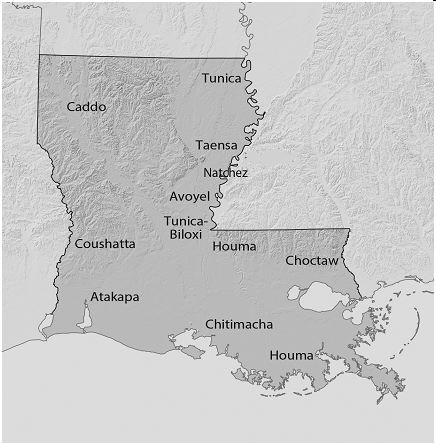
How is the location of the Natchez settlement related
to the 1729 White Apple Village conflict?
a. | French officials forcibly removed the Natchez to set up
salt mines. | b. | Spanish officials
slaughtered the Natchez to gain control of Natchez river ports. | c. | Neighboring tribes fought the Natchez to gain fishing rights along the
Mississippi. | d. | French officials
ordered the Natchez to abandon their village to gain control of the fertile
land. |
|
|
|
2.
|
Read the passage and then answer the next question.
Du Pratz recorded the concerns expressed by one Natchez elder: “Before the French
came amongst us, we were men, content with what we had.” Another Natchez chief believed that
the trading relationship with the French meant only that his people had to deprive themselves of a
“part of our corn, our game, and fish, to give a part to them.”
Which
explains what concerned the Natchez elders about trading with the French?
a. | trade-offs | b. | opportunity costs | c. | supply and
demand | d. | opportunity
benefits |
|
|
|
3.
|
How did the arrival of European settlers affect the
Native American population in Louisiana?
a. | Native American populations increased after European
settlement. | b. | Native American
populations decreased after European settlement. | c. | Native American populations decreased before European
settlement. | d. | Native American
populations were unaffected by European settlement. |
|
|
|
4.
|
Why are there no written records of Native
Americans from the years before European settlement?
a. | Early natives had no
language. | b. | Early paper was fragile and was destroyed over
time. | c. | Natives followed an oral tradition of handing down
stories. | d. | They were all destroyed during the American
Revolution. |
|
|
|
Study the time line and then answer the question.

|
|
|
5.
|
Which event occurred in 1731?
a. | Natchez survivors disperse, ending the
tribe. | b. | Natchez sell their lands along the Mississippi to the
French. | c. | France agrees to share tobacco profits with the Natchez
tribe. | d. | The U.S. government recognized Natchez as a sovereign
Indian nation. |
|
|
|
6.
|
Which event occurred in AD 1718?
a. | Natchez arrive in Louisiana | b. | Late Neo Indian period began | c. | Oldest mounds in Louisiana built | d. | Du Pratz encounters several native
tribes |
|
|
|
7.
|
Which is the best resource for learning about the
daily lives of prehistoric Native American tribes?
a. | pottery fragments | b. | color photographs | c. | diary
entries | d. | newspaper
articles |
|
|
|
8.
|
Read the passage and then answer the question.
Du Pratz recorded the concerns expressed by one Natchez elder:
“Before the French came amongst us, we were men, content with what we had.”
What conclusion could be drawn from this statement?
a. | Natives chose not to interact with French
settlers. | b. | Natives abandoned their cultures for French
traditions. | c. | Native cultures
and lifestyles began to change when the French arrived. | d. | Native cultures and lifestyles were unaffected by the arrival of the
French. |
|
|
|
9.
|
What are the four stages of Louisiana’s
prehistory?
a. | Prehistoric Indian, Paleo Indian, Meso Indian, and Neo
Indian | b. | Paleo Indian, Meso Indian, Early Neo Indian, and Late
Neo Indian | c. | Paleo Indian,
Early Meso Indian, Late Meso Indian, and Neo Indian | d. | Prehistoric Indian, Meso Indian, Early Neo Indian, and Late Neo
Indian |
|
|
|
Study the time line and then answer the question. 
|
|
|
10.
|
Which event could be added between 7500 and 5000
BC?
a. | Native populations decreased due to small pox
outbreak. | b. | Native people stopped hunting and turned to
agriculture. | c. | Native migration
patterns continued to mirror those of the Mastodon. | d. | Native people began to hunt smaller prey and settle for longer
periods. |
|
|
|
11.
|
What conclusion can be drawn from the
timeline?
a. | Meso Indians buried Paleo Indians in their
mounds. | b. | In 7500 BC, Louisiana experienced another ice
age. | c. | Neo Indians traded pottery for guns and
ammunition. | d. | By AD 800,
Louisiana’s native populations built settlements. |
|
|
|
12.
|
What conclusion can be drawn about the cultural
shift to permanent settlements by the end of the Late Neo Indian period?
a. | Over hunting and fishing lowered game populations
forcing tribes to settle and begin farming. | b. | Herds of large
animals settled in the rich lands of Louisiana eliminating the need to move
frequently. | c. | Trading with the
French for guns simplified hunting, eliminating the need to follow herds of
animals. | d. | New technologies complimented Louisiana’s rich
natural and biological resources eliminating the need to move
frequently. |
|
|
|
13.
|
What is intercropping?
a. | planting crops in between
homes | b. | planting different crops each
season | c. | planting crops every other growing
season | d. | planting multiple crops in the same plot at the same
time |
|
|
|
14.
|
How did the arrival of European explorers and
settlers challenge Native Americans living in Louisiana?
a. | Natives had to begin using guns to hunt game for
food. | b. | Native populations did not have immunity to European
illnesses. | c. | Natives worked
hard to teach European settlers their languages. | d. | Natives had to farm twice as much land to provide food for the increasing
population. |
|
|
|
15.
|
DeSoto’s Exploration
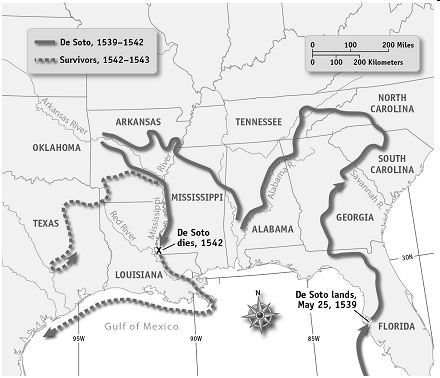 Native American Tribes in the 1500s Native American Tribes in the 1500s
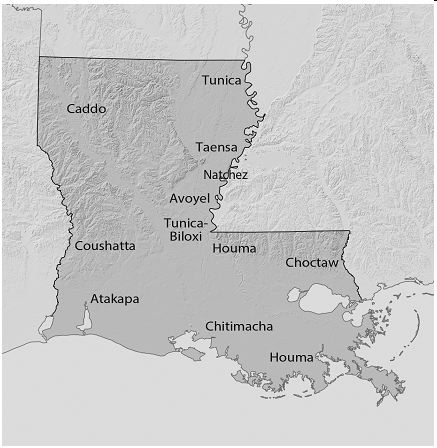 Which Native American group would have been most
affected by Hernando de Soto’s exploration of Louisiana? Which Native American group would have been most
affected by Hernando de Soto’s exploration of Louisiana?
a. | Atakapa | b. | Caddo | c. | Houma | d. | Tunica |
|
|
|
16.
|
Discovery of the Mississippi
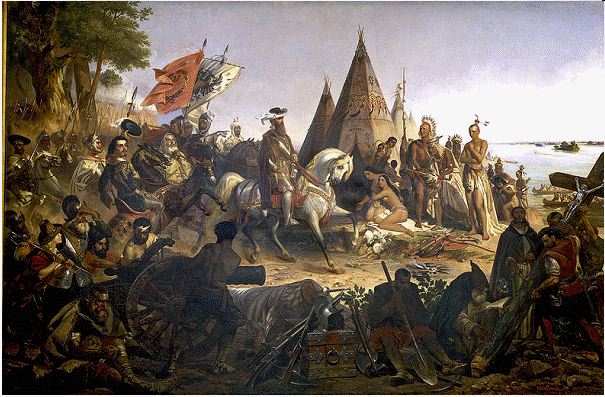 What conclusion can be drawn from this painting of Hernando de
Soto? What conclusion can be drawn from this painting of Hernando de
Soto?
a. | Native tribes embraced de Soto, his army, and his
religious beliefs. | b. | Hernando de Soto
considered native chiefs as equal in power to himself. | c. | Native tribes had no desire to forge peaceful relationships with Spanish
explorers. | d. | Hernando de Soto
intended to claim land and riches for Spain by any means
necessary. |
|
|
|
17.
|
Which is an example of how the introduction of
European trade goods affected the lives of Native Americans?
a. | Horse meat replaced small game as a dietary
staple. | b. | European style clothing was used to define tribal
status. | c. | Pots allowed them to cook their meat instead of eating
it raw. | d. | Guns changed the way they hunted and fought among
themselves. |
|
|
|
18.
|
Which two tribal groups ceased to exist within
thirty years of the arrival of the French in Louisiana?
a. | Atakapa and Natchez | b. | Caddo and Chitimacha | c. | Choctaw and
Houma | d. | Tunica and
Natchez |
|
|
|
19.
|
Study the time line and then answer the question.  Which event would complete the timeline? Which event would complete the timeline?a. | moved west to Texas | b. | settled along Red River | c. | began to trade
with Americans | d. | border disputes
between French and Spanish settlers |
|
|
|
20.
|
Why did the Caddo Indians sign a treaty with the
United States in 1835?
a. | to end the French and Indian
War | b. | to sell their land for cash and trade
goods | c. | to establish themselves as a sovereign
nation | d. | to ensure a lasting trade relationship with the U.S.
government |
|
|
|
21.
|
Which is a direct result of the arrival of Spanish
conquistadors in North America?
a. | Native American populations increased
rapidly. | b. | Tribes gave up their religions to become
Catholic. | c. | Native Americans learned new farming
techniques. | d. | Native Americans
became skilled at horseback riding. |
|
|
|
22.
|
How was the location of the Chitimacha tribe
related to the yellow fever epidemic in 1855?
a. | Location played no part. The arrival of European
explorers and settlers were to blame. | b. | There was flooding
of the Mississippi River which made it difficult for doctors to bring medicine to the
tribe. | c. | Watery marsh land and a subtropical climate were perfect
for the growth and development of mosquitos. | d. | The continual
change and loss of the wetlands made it impossible for tribes to grow the plants needed to cure those
infected. |
|
|
|
23.
|
Who is responsible for the governance of the modern day Chitimacha tribe?
a. | Governor of Louisiana | b. | Mayor of St. Mary’s
Parish | c. | Tribal Council Members | d. | United States
government |
|
|
|
24.
|
Which groups of people make up the Natchez class
system?
a. | king, nobles, and stinkards | b. | chief, governor, and stinkards | c. | president, governor, and mayor | d. | chief, tribal council, and shaman |
|
|
|
25.
|
How did the French and Indian War contribute to an
internal Choctaw tribal war?
a. | French propaganda convinced the natives to destroy each
other. | b. | Following the war, the tribe split into two factions
each allied with opposing nations. | c. | Low on food and
other supplies, the tribesmen turned against each other for survival. | d. | Having their lands taken by the French during the war, the Choctaw were forced
to fight one another to reclaim their settlements. |
|
|
|
26.
|
Mary is conducting a research project on the
cultural history of the Choctaw tribe.
What would be the most reliable source of
information for her project?
a. | blog hosted by Choctaw
children | b. | Choctaw tribal center in Grant
Parish | c. | newspaper articles | d. | social studies textbook |
|
|
|
Houma Settlement History
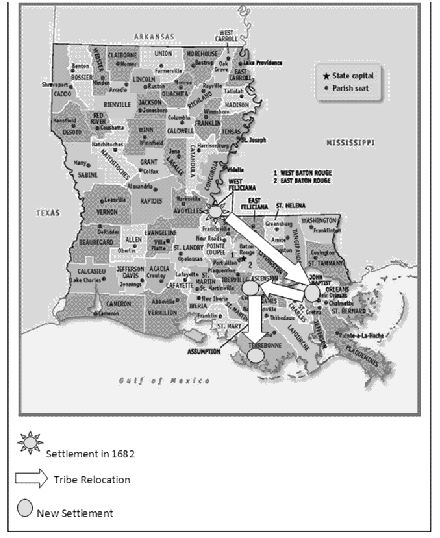
|
|
|
27.
|
Which conclusion about the Houma can be drawn from
the map?
a. | The Houma tribe did not have disputes over land because
they continued to move. | b. | The culture and
lifestyle of the Houma tribe has remained unchanged throughout its
history. | c. | The Houma tribe relocated several times before settling
in the marshlands of Louisiana. | d. | The Houma tribe
followed large herds of mastodons until they settled along the coast of
Louisiana. |
|
|
|
28.
|
Tunica-Biloxi Settlement
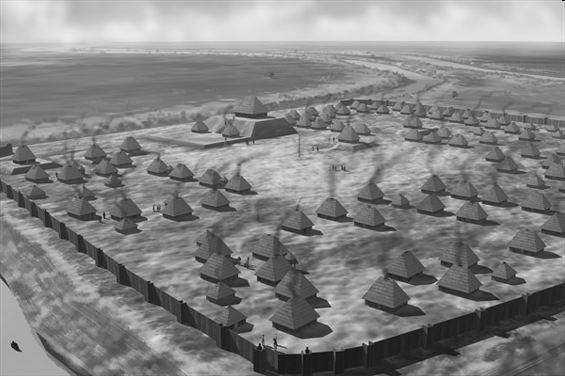
Which explains how the location of
Tunica-Biloxi settlements impacted trade?
a. | Coastal living allowed them to trade directly with
Europe. | b. | Marsh settlements made crawfish their primary trade
good. | c. | The location of the tribe did not directly affect its
ability or need to trade. | d. | Settling along
waterways allowed them to travel long distances to trade with other
tribes. |
|
|
|
29.
|
Which explains why the Tunica-Biloxi tribe had two
chiefs?
a. | They were the largest tribe in
Louisiana. | b. | One led all tribal
affairs while the other led the military. | c. | Tribal settlements
were spread out throughout Louisiana. | d. | One supervised the
women and children while the other led the men. |
|
|
|
30.
|
How were the Tunica tribe’s trading skills
related to their relationship with French and Spanish settlers?
a. | The Tunica refused to trade their goods with the
settlers. | b. | The Tunica used trade as a way to control their
relationships with the settlers. | c. | The Tunica were
specialized salt traders, so they only interacted with the settlers from time to
time. | d. | The Tunica traded their goods at a higher cost than
other tribes, causing many conflicts with the settlers. |
|